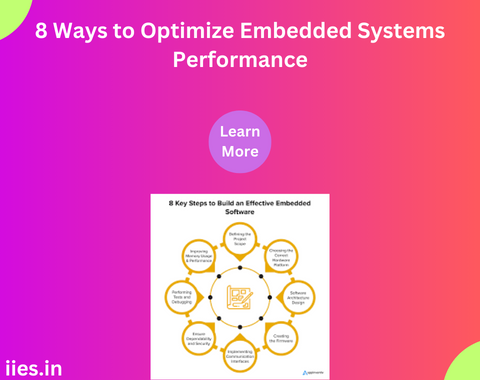
In the realm of technology, embedded systems play a pivotal role in powering a plethora of devices we encounter daily, ranging from smartphones to medical devices and automotive systems. These compact yet powerful systems are designed to perform specific functions efficiently within constrained environments. However, as demands for functionality and performance increase, optimizing embedded systems becomes paramount to ensure optimal operation. Here, we delve into eight essential strategies to enhance the performance of embedded systems.
Efficient Resource Utilization:
The cornerstone of optimizing embedded systems lies in efficient resource utilization. This encompasses managing CPU cycles, memory, and power consumption judiciously. Utilize profiling tools to identify performance bottlenecks and optimize critical code sections. Moreover, employ efficient algorithms and data structures tailored to the specific requirements of the application to minimize resource overhead.
Compiler Optimization:
Compiler optimization plays a crucial role in enhancing the performance of embedded systems. Leveraging compiler flags and optimization techniques can significantly improve code efficiency. Utilize techniques such as loop unrolling, function inlining, and instruction scheduling to generate optimized machine code. Additionally, explore compiler-specific optimization options tailored to the architecture of the embedded platform to unlock performance gains.
Hardware Acceleration:
Harness the power of hardware acceleration to offload computationally intensive tasks from the CPU. Utilize specialized hardware components such as DSPs (Digital Signal Processors), FPGAs (Field-Programmable Gate Arrays), or dedicated coprocessors to accelerate specific functions like signal processing, encryption, or image processing. By leveraging hardware acceleration, you can achieve significant performance improvements while minimizing the burden on the CPU.
Real-time Operating Systems (RTOS):
Employing a real-time operating system tailored to the requirements of the embedded application can streamline task scheduling and resource management. RTOSs offer deterministic behavior, ensuring timely execution of critical tasks. Utilize features such as priority-based scheduling, interrupt handling, and efficient memory management to optimize system performance. Additionally, optimize task synchronization and communication mechanisms to minimize overhead and latency.
Power Management:
Efficient power management is essential for optimizing embedded systems, particularly in battery-powered devices. Implement power-saving techniques such as dynamic voltage and frequency scaling (DVFS), where the CPU adjusts its operating frequency and voltage dynamically based on workload requirements. Utilize low-power modes during idle periods and employ techniques like clock gating to minimize power consumption without compromising performance.
Cache Optimization:
Effective cache utilization is vital for improving memory access latency and overall system performance. Optimize memory access patterns to maximize cache hits and minimize cache misses. Employ techniques such as data prefetching, cache line optimization, and cache blocking to enhance cache efficiency. Additionally, align data structures and code segments to cache boundaries to leverage spatial locality and minimize memory latency.
Code Optimization:
Fine-tuning code for performance is a fundamental aspect of optimizing embedded systems. Analyze and refactor code to eliminate inefficiencies, reduce redundant computations, and minimize code size. Employ techniques such as loop optimization, algorithmic improvements, and code specialization to streamline execution paths and improve overall performance. Furthermore, leverage platform-specific optimizations and intrinsic functions to exploit hardware capabilities effectively.
System-Level Optimization:
Adopt a holistic approach to system-level optimization by considering the interactions between software and hardware components. Profile system behavior under varying workloads and operating conditions to identify optimization opportunities. Optimize system configuration parameters, such as interrupt priorities, clock frequencies, and peripheral settings, to achieve optimal performance and responsiveness. Additionally, employ techniques like task consolidation and parallelism to maximize resource utilization and throughput.
Selecting the Right Hardware: The foundation of an efficient embedded system lies in selecting hardware components that match the application’s requirements. This involves considering factors such as processing power, memory capacity, and energy efficiency. Choosing the most suitable microcontroller, microprocessor, or System-on-Chip (SoC) can significantly impact performance.
Efficient Algorithm Design: Optimize algorithms to minimize computational complexity and memory usage. Use techniques like dynamic programming, data compression, and algorithmic trade-offs to achieve faster execution and conserve resources. Tailor algorithms to the specific tasks and constraints of the embedded system to maximize efficiency.
Compiler Optimization: Compiler optimization plays a crucial role in improving code efficiency. Configure compilers to generate optimized code tailored to the target hardware architecture. Enable compiler optimizations such as loop unrolling, function inlining, and instruction scheduling to enhance performance without sacrificing code readability or maintainability.
Memory Management: Efficient memory management is vital for embedded systems to minimize memory footprint and access latency. Employ techniques like memory pooling, dynamic memory allocation optimization, and data structure alignment to reduce memory fragmentation and overhead. Utilize non-volatile memory solutions like Flash memory for persistent storage to enhance reliability and performance.
Power Optimization: Power efficiency is paramount in embedded systems, especially for battery-powered devices. Implement power-saving techniques such as clock gating, voltage scaling, and low-power modes to minimize energy consumption during idle periods or low activity. Utilize power profiling tools to identify and optimize power-hungry components or software routines.
RTOS and Task Scheduling: Real-Time Operating Systems (RTOS) provide efficient task scheduling mechanisms crucial for managing system resources effectively. Utilize priority-based scheduling algorithms to allocate CPU time to critical tasks while ensuring timely responsiveness. Optimize task scheduling policies and parameters to minimize overhead and maximize system throughput.
In conclusion, optimizing embedded systems performance is a multifaceted endeavor that requires a combination of software and hardware optimizations tailored to the specific requirements of the application. By employing strategies such as efficient resource utilization, compiler optimization, hardware acceleration, and power management, developers can unlock the full potential of embedded systems while meeting stringent performance requirements. Embracing a systematic approach to optimization and leveraging cutting-edge techniques are key to maximizing efficiency and enhancing the performance of embedded systems in the ever-evolving landscape of technology.
Indian Institute of Embedded Systems – IIES